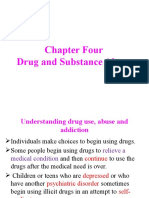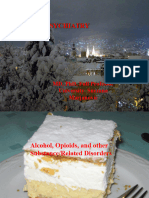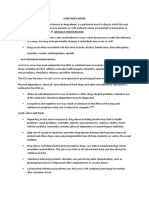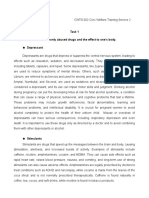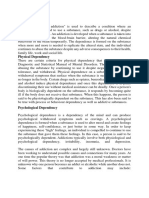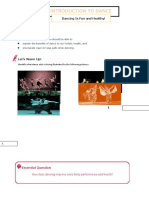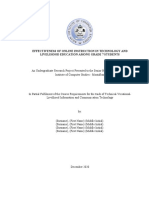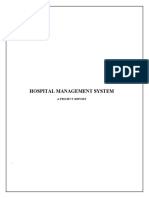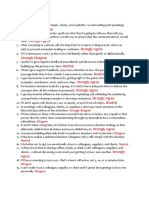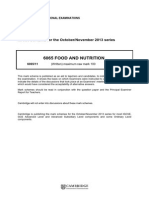Introduction
Substance use disorders involve excessive use of nicotine, alcohol, and other illicit substances that leads to social, academic, and occupational impairment. The most common illicit substances seen include cannabis, sedatives, hypnotics, anxiolytics, inhalants, opioids, hallucinogens, and stimulants. The specific factors of substance use disorder consist of abuse, intoxication, and physical/psychological dependence. When a person uses a substance it can have various effects such as : Acute intoxication: A transient condition following the use of alcohol or other psychoactive substances resulting in alteration in level of consciousness, perception, mental functions, behaviour and other physiological functioning. The level of alteration depends on the quantity of substance used and blood levels of the substance. Harmful use: A pattern of psychoactive substance use that is causing damage to health. The damage can be in the form of physical damage (eg: alcohol liver disease) or psychological (eg: episodes of depression secondary to alcohol consumption) Addiction/ Dependence syndrome: A definitive diagnosis of dependence can be made only if the following symptoms were present together at some point in the last year: A regular pattern of substance use, especially early morning usage is present Experience withdrawal symptoms when he/she does not use or reduce substance amount F1x.0 Acute intoxication .00 Uncomplicated .01 With trauma or other bodily injury .02 With other medical complications .03 With delirium .04 With perceptual distortions .05 With coma .06 With convulsions .07 Pathological intoxication F1x.1 Harmful use F1x.2 Dependence syndrome .20 Currently abstinent .21 Currently abstinent, but in a protected environment .22 Currently on a clinically supervised maintenance or replacement regime [controlled dependence] .23 Currently abstinent, but receiving treatment with aversive or blocking drugs .24 Currently using the substance [active dependence] .25 Continuous use .26 Episodic use [dipsomania]

F1x.3 Withdrawal state .30 Uncomplicated .31 With convulsions F1x.4 Withdrawal state with delirium 1 .40 Without convulsions .41 With convulsions F1x.5 Psychotic disorder .50 Schizophrenia-like .51 Predominantly delusional .52 Predominantly hallucinatory .53 Predominantly polymorphic .54 Predominantly depressive symptoms .55 Predominantly manic symptoms .56 Mixed F1x.6 Amnesic syndrome F1x.7 Residual and late-onset psychotic disorder .70 Flashbacks .71 Personality or behaviour disorder .72 Residual affective behaviour .73 Dementia .74 Other persisting cognitive behaviour .75 Late-onset psychotic disorder F1x.8 Other mental and behavioural disorders F1x.9 Unspecified mental and behavioural disorder Different substances can be classified based on their effects on the central nervous system. These effects vary depending on the substance and can produce everything from increased energy and euphoria to profound sedation. In general, while the effects vary significantly, the initial stages of substance use disorders are characterized by positive reinforcement, where individuals experience a sense of well-being or euphoria with use. As physiological and psychological dependence progresses, an individual experiences negative reinforcement where substances primarily relieve dysphoria and unpleasant withdrawal symptoms.
Etiology
The cause of substance use disorders is multifactorial and includes psychological, biological, socio-cultural, and environmental factors. Co-morbid psychiatric disorders have been associated with an increased risk of illicit substance use. For example, those with attention
deficit hyperactivity disorder (ADHD) and bipolar affective disorders have an increased risk of developing a substance use disorder in adulthood compared to the general population. Environmental and genetic factors also play a strong role in substance use disorder. An individual's genetic make-up for stress-response predisposes the risk of dependence on substances. Individual variations in genetics have been demonstrated to influence stress response and predispose some individuals to develop a substance use disorder .[1]
The Adverse Childhood Experience Study (ACES) demonstrated that exposure to a range of traumatic events during childhood is associated with an increased risk of substance use later in life. This risk association was demonstrated to follow a dose-response-like pattern where increased trauma exposure was directly correlated with increased risk of developing a substance use disorder.
Epidemiology
The cause of substance use is multifactorial. It includes psychological, biological, socio-cultural, and environmental factors. Some mental health disorders predispose individuals to abuse illicit substances; for example, those with ADHD have a high chance of abusing illicit substances in their adulthood .[1]
Cannabis is the most common abused drug in the United States.[2]
The Services Administration for Mental Health and Substance Abuse (SAHMSA), the National Institute on Alcohol Abuse and Alcoholism (NIAAA), and the National Institute of Drug Abuse (NIDA) have accumulated data on substance use and its consequences over the years. Studies show individuals who abuse one substance are more like to abuse other substances as well. In 2012, studies showed that the lifetime prevalence of alcohol use disorder was 8%, and illicit substance use was 2-3%.[3]
A cross-sectional study was conducted in the US with 36,309 adults, and the data was obtained from April 2012 to June 2013. The study showed a 12-month prevalence of substance use disorder was 3.9% and lifetime substance use disorder was 9.9%. Substance use disorder was more prominent among certain population groups. They were men, Caucasian, Native Americans, young single or previously married adults, lower educated individuals, lower-income individuals, and those residing on the Western side of the country. There was a significant association with individuals with disabilities, with a 12-month prevalence of 13.5% and a lifetime prevalence of 24.6%.[4]
Pathophysiology
Substance use disorders involve both psychological and physical dependence on the substance(s) of use. Severe dependence is characterized by an inability to regulate use. Substance use disorders and addiction stem in part from adaptive changes in the brain as it seeks to regain homeostasis.[5] Chronic and/or prolonged stress plays a strong role in
developing drug-seeking behavior; it alters the corticotropin-releasing factor and hypothalamic-pituitary-adrenal axis (CRF/HPA)". In animal model studies, it demonstrated CRF circuitry could increase "dopamine activity in the mesolimbic reward circuit."[6]
Stimulants, specifically cocaine and amphetamines, exert their effect by preventing the recycling of dopamine, norepinephrine, and serotonin. This results in increased concentrations of these neurotransmitters within the synaptic cleft. The influx of these neurotransmitters gives the user a euphoric effect.[7]
Worldwide and in the United States, tobacco use disorder is the most prevalent addiction. Most commonly, nicotine is absorbed through the lungs when individuals burn and inhale tobacco products. It is absorbed through the pulmonary circulation, crosses the blood-brain barrier in less than 10 seconds, and attaches to the nicotinic cholinergic receptors in the central nervous system (CNS). The metabolite of nicotine is cotinine, which can be detected as a urinary marker of the substance.[8] Nicotine influx in the CNS leads to
neurotransmitters' release, especially dopamine, which
stimulates the brain’s
reward area. Chronic nicotine use results in tolerance, when excessive stimulation of nicotine acetylcholine receptors results in desensitization of the receptors; these neuroadaptations produce a state where the brain requires nicotine to function in homeostasis. This is referred to as physiological dependence.[9] CYP2D6 metabolizes
nicotine. Therefore, it can alter the metabolism of other medications, such as antipsychotics. Alcohol produces euphoric effects through the dopamine neurons of the mesolimbic system. Alcohol inhibits NMDA receptors and results in the upregulation of GABA receptors. Chronic consumption of alcohol leads to GABA receptor desensitization and tolerance, potentiating the loss of drinking control.[10] Alcohol is mostly absorbed in the
digestive tract's mucosal lining, specifically at the proximal small intestine, where B vitamins are absorbed. Individuals who drink excessively may have a deficiency of B vitamins.[11] Vitamin B1 (Thiamine) and vitamin B9 (Folic Acid) are the two most common
B-vitamins deficiencies. Deficiency of thiamine can lead to neurological findings such as hyporeflexia and sensory and motor deficiency. More profound deficiencies over time can lead to Wernicke's Encephalopathy and Korsakoff syndrome [12]. Chronic alcohol
consumption can also result in Vitamin B9 (Folic acid) deficiency; after 8-16 weeks of deficient stores of folic acid in the body, individuals may develop "glossitis, angular stomatitis, and oral ulcers," along with "depression, irritability, insomnia, cognitive decline, fatigue, and psychosis."[13]
Opioids include codeine, heroin, hydrocodone, hydromorphone, methadone, meperidine, mor phine, and oxycodone. Opioids bind to delta, kappa, and mu receptors, which provide analgesia for severe pain and produce euphoria feelings. Higher doses carry a risk of respiratory suppression and death. Individuals with chronic exposure to opioids can experience profound withdrawal symptoms if opioid use is stopped abruptly. The withdrawal symptoms include but are not limited to diarrhea, excess sweating, excess lacrimation, nausea, vomiting, and insomnia.[14]
Sedative, Hypnotic, Anxiolytics are a class of medications that can cause CNS depression, and if taken inappropriately, the effects can be fatal. They include benzodiazepines: alprazolam, clonazepam, lorazepam, diazepam, chlordiazepoxide; Barbiturates: phenobarbital, pentobarbital, butabarbital; it also includes other sedative medications. Other classes of drugs have properties that share a similar mechanism of action with benzodiazepine and barbiturates. These agents mediate gamma-aminobutyric acid (GABA) effects, producing inhibitory effects within the central nervous system. Alcohol can be classified in this group, but alcohol is more commonly used and is not utilized therapeutically, so healthcare experts have classified it separately.[15] The euphoric and
sedative effects of these agents precipitate and perpetuate a cycle of overuse and dependence.


